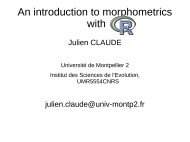Protocols for field and laboratory rodent studies - HAL
Protocols for field and laboratory rodent studies - HAL
Protocols for field and laboratory rodent studies - HAL
Create successful ePaper yourself
Turn your PDF publications into a flip-book with our unique Google optimized e-Paper software.
Background: CERoPath projectCERoPath (Community Ecology of Rodents <strong>and</strong> their Pathogens in a changing environment,www.ceropath.org) is a 4-year (2008-2011) project funded by the French Ministry of Research (FrenchANR Biodiversity ANR 07 BDIV 012). It involves scientists from France, Thail<strong>and</strong>, Laos, Cambodia <strong>and</strong>Finl<strong>and</strong>.The CERoPath project investigates the structure ofmurine <strong>rodent</strong> communities, their pathogens(microparasites) <strong>and</strong> their macroparasites (helminths<strong>and</strong> arthropods) in three South-East Asian countries,Cambodia, Lao P.D.R. <strong>and</strong> Thail<strong>and</strong>. South-East Asiais characterized by a high biodiversity (hotspot),threatened by rapid environmental changes under thepressure of economic development <strong>and</strong> insertion intothe global economy. In South-East Asia, <strong>rodent</strong>s arehosts <strong>and</strong> vectors of several agents causing diseasesincluding leptospirosis, scrub typhus, viralhemorrhagic fevers <strong>and</strong> plague in humans <strong>and</strong>trypanosomiasis in livestock.Seven sampling sites (Fig. 1) were selected along theMekong River in:- Thail<strong>and</strong>: Nan, Loei <strong>and</strong> Buriram provinces,- Lao PDR: Luang Prabang <strong>and</strong> Champasakprovinces (Pakse),- Cambodia: Mondolkiri <strong>and</strong> Krong PreahSihanouk provinces (Veal Renh).These locations represent a gradient of de<strong>for</strong>estation<strong>and</strong> human pressure, from highly <strong>for</strong>ested areas withlow human density, to poorly <strong>for</strong>ested areas with highhuman density.Rodents were sampled twice in each site: during thedry season (November-May) <strong>and</strong> during the rainyseason (June-October).Figure 1: Location of the seven CERoPathsampling sites in South-East AsiaThis project is based on the concepts <strong>and</strong> methods of evolutionary ecology <strong>and</strong> aims to:- characterize the likely processes that contribute to the observed patterns of host-pathogenassemblages, taking into account the ecological environment of <strong>rodent</strong> communities (using remotesensing <strong>and</strong> geographic in<strong>for</strong>mation systems) <strong>and</strong> the evolutionary history of the interacting species(using population genetics, molecular epidemiology <strong>and</strong> community phylogenetics);- build projections of host <strong>and</strong> pathogen community change associated with ecological change, throughthe help of spatial analysis.Consequently, this book should be considered with the background of the CERoPath project, inthe geographical context of South-East Asia. Nevertheless, authors have tried to make in<strong>for</strong>mation <strong>and</strong>recommendations as general as possible to help further <strong>studies</strong> of <strong>rodent</strong>s <strong>and</strong> <strong>rodent</strong>-borne diseasesin other contexts.V



